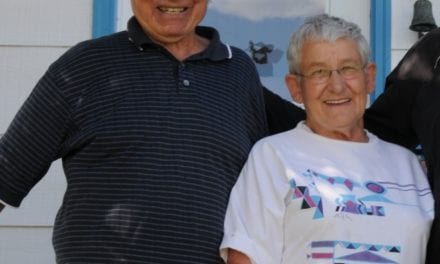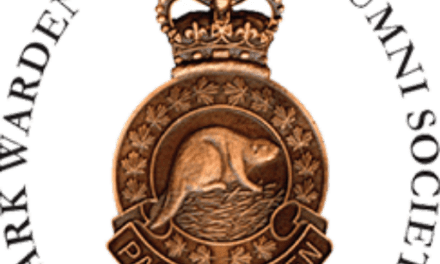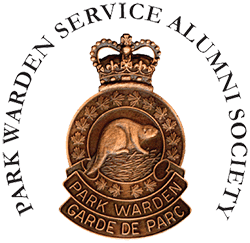Thank you to the Whyte Museum of the Canadian Rockies for granting permission to the Park Warden Service Alumni to post this interview on our website
Park Warden Alumni Society of Alberta
Oral History Project – Spring 2014
Telephone Interview with Ron Chambers
Interviewed by Christine Crilley-Everts
May 13, 2014
Place and Date of Birth: Whitehorse, Yukon. September 16, 1943.
Occupations: After working for the Department of Indian Affairs, Ron joined the Yukon Native Brotherhood, an organization dedicated to securing land claim settlements in the territory. (http://cyfn.ca/history/history-of-land-claims). Following some cultural grant work for the federal government, Ron was hired as a park warden during the establishment of the Kluane National Park. To learn the warden ropes, he spent a few seasons in Jasper before returning to the north, where he stayed for the rest of his 22 year warden career. As a warden in Kluane, he played a major role in search and rescue activity, as well as in communication and liaison work with local communities and Parks Canada. Ron was actively involved with land claims negotiations and with the Park Management Board. He left the warden service in 1990 to focus on cultural and historical work within his community.
Additional Information: Ron is a member of the Champagne and Aishihik First Nation and in 1999, he served as the Deputy Chief. His family has a long tradition in Kluane National Park, Kluane is a family name and Louise Lake in the park was named after his grandmother. Ron has been involved in a number of archaeology projects in the north. “He is credited with “rediscovering” the Hoodoo Mountain obsidian source in Kluane National Park. He also led the 1993 archaeology survey effort to relocate the 19th century Tatshenshini River native fishing villages. (http://www.yhrb.ca/Board_Pages/Ron_Chambers.htm). Ron was the first Yukoner and First Nation man to climb Mount Logan in 1975. He was also part of the RCMP centennial climb to Mount Steele in 1990.
“My first question is what is your place and date of birth?”
(0:19) Whitehorse, Yukon. September 16, 1943. No, I lived a couple of hundred kilometers northwest of Whitehorse, in a place called Burwash Landing. They had a flight strip there that they utilized just during the war. When the Alaska Highway was built, they built a flight strip in that area and there is an old native village site in that area as well. Yeah, my father was born in a place called Champagne. It’s oh, about 100 kilometers from Whitehorse, and my mother was born just beyond Burwash. So they are both from here. No, my wife is from Tsawwassen, British Columbia.
How did you two meet?
She was a summer employee in Burwash, back in the 1970s.
“I remember last time we spoke, your wife was on her way to Red Deer because one of your daughters was about to have a baby.”
Yep, they had a baby girl since then. I have a son and two daughters That’s the first and only grandchild so far…
“How did you become involved in the warden service?”
(2:51) Well, what can I call it, the right place at the right time sort of thing. I was doing other jobs, I was with the government previous. I was with Indian Affairs at one time for a couple of years. I worked for the Indian Affairs department as what they used to call the Indian Agent actually. Then I ended up going to Yukon Native Brotherhood, which was a precursor to Land Claims of the Yukon…Then I was working with a grant from the government for a couple of years doing cultural activity. But of course they made the park out of my backyard pretty well. So I came over here and I talked with the people who were involved with the parks at the time. There were only two people working here, just kind of setting it up I guess. They said, “Well, if you are interested put your name in and see what you can do.” So I did and I ended up getting a seasonal job and that was the beginning of it.
“That was in Jasper was it?”
Well, I qualified here in the Yukon, but they kind of recommended that I go to Jasper as a seasonal to learn what the ropes were I guess working with the parks. I ended up in Jasper for a couple of years. That was about 1973.
. “From Jasper then did you return to the north, or did you work in another park?”
No, I interviewed for Wood Buffalo the one time and I was offered the position even, but there was another person interested and I still had my interests with Kluane It was seasonal, it was summertime work mainly, although in Jasper I stayed on year round. But I thought, well in the winter, I might go trapping or work with Parks, but then an opportunity came to work back in Kluane, so I ended up back here…
(5:51) Hans Fuhrer, I worked with Hans Fuhrer in Jasper, on the Banff Jasper Highway in the Sunwapta area with avalanche control (in the winter) and during the summer, I worked on the highway. (Hans Fuhrer worked as a warden for 25 years in Jasper, Kluane and Kootenay National Park. He spent the majority of his career working in public safety.) He transferred up here (to Kluane) as sort of a warden/alpine specialist. He set up the search and rescue for Kluane because we had the highest mountains in Canada at the time and some of the highest in North America. So Hans came up here to help put that together.
“Then did you spend the rest of your career in Kluane?”
Yep, pretty well, for a couple of years I worked out of Inuvik…they were establishing a park in that area. So, I worked up there with Ray Frey, talking to people and having meetings, doing slideshows for people to show what Parks were about and that sort of a thing. I did a bit of it as well with the Haida Gwaii…talking to people and part of that was because of my First Nation background to try and just let people know what parks were all about.
“Did you find people receptive or was there some trepidation?”
Yeah, they weren’t too sure at first They were far removed from what the parks are and very few people in the north had actually been through the national parks that existed at the time. They were so far away for one thing. People at the time weren’t into traveling as much as they are now. So there was very few people, the local people anyways, we’ll call them local people, that knew much about parks as such, but they were kind of wondering what it was all about.
“When you first started was there any kind of awareness in terms of First Nation land use and culture within the national parks?”
(8:11) Very little and I say that as a person, well my background is art, as a performer/dancer I was never requested or asked to do a performance for the people I actually worked for in all those years. I’ve traveled to Europe and I have traveled to Japan and Taiwan and places like that. But I never traveled in the Parks in the same capacity. Well, that is one of the reasons I kind of took it on, is I thought the parks were dismissing it…They oriented it only to wildlife you know….And then culture came on later. That was too bad because a lot of history (was lost) during that period of time…
(“In your years in Kluane then, what were some of your responsibilities?” You started to work with the Parks Management Board or was that later on?”
(9:30) Park Management Boards is after the Land Claims…So a big part of that was to talk to people about Parks what Parks were After spending a couple of years in Jasper, I had an idea of what the on ground part was in a park like Banff or Jasper that were busy with people. So I got that background to it. But the thing that I always pushed for of course was always the cultural and historical side of the park. On a personal basis, I ended up a little more directly involved in the search and rescue stuff, more on a physical basis I guess. Because I am not an intellectual or anything like that, I am dyslexic as a matter of fact, and I can barely read or write. I wasn’t contributing much along those lines, so I ended up getting quite involved with the search and rescue and communication side of things with people.
“With the search and rescue are there any stories that stick out in your mind?”
(11:00) Well, there is quite a few stories actually.
Each one (rescue) is individual to themselves, but each one is totally different than the other. So you train for as much as you can, but they are always unexpected and they are always different. The training can be similar, I mean we did a lot of stuff in the mountains, but it wasn’t always mountains either. People challenge themselves in a variety of ways and you kind of have to be prepared for whatever it is. You try to prepare for them all, but…The main thing we prepared a lot for was the mountaineering…because that was where the biggest number one danger was, people getting into extreme situations in the (mountains), it is an extreme challenge with everybody for a variety of reasons, so that was probably the number one, but after that it was things like water and whatever. I mean in a national park, people are always doing something, getting lost, or falling in rivers, thing like that. When people are doing things, things happen.
“When we spoke last you also talked about the use of helicopters, did you work with helicopters a lot in terms of the rescues?”
(12:35) Yeah, helicopters were the number one mode of getting around the park at the time I mean this is the second largest park in Canada and probably the second largest park in the world. It was quite unexplored back in the icefields area for one. The only way to actually get in there at anytime is in an aircraft, one way or the other, mainly through helicopters. We also had in the very beginning, in the first number of years we used the helicopter a lot for wildlife patrols because there was a fair amount of poaching going on at the time, mostly from Alaska. Nobody was ever looking at the boundary much, some of these guys almost had their own airstrips in the park at the time right on the Canadian side. So for the first few years a lot of that (helicopter use) was to cover that as well. We did a lot of flying actually. There are no roads in the park as such. I think the road that goes back the furthest right now into the park is probably, I would say, is 10/15 kilometers. And that is it for the whole park! The other way is to either hike or ski and we wouldn’t have snowmobiling in the park per se, so flying is the major way for people to get into the icefields.
“Did you enjoy the mountaineering?”
(14:33) Well, I was born and raised in the mountains…for me mountains were where you went to go to hunt sheep, things like that. You know, I never did really look at it as any other reason to be going up into those mountains. But once you worked in the parks, with the mountains, and people are climbing and things like that, then you take on a total different perspective. It becomes a total different lifestyle. Once I started realizing the mountaineering (opportunities) and what not, it became a total different focus. I give a quote to people often about when I climbed Mount Logan with Lloyd Freese and Hans Fuhrer…in 1975. We went to the top and I came down and an elderly lady at the store here said to me, “I hear you climbed that big mountain there.” I said, “Yeah.” She said, “Sheep there?” “No.” “Goats there?” “No.” “Then what did you go there for?” That’s the perspective of the First Nations people of the area, that unless you’ve got a particular reason why you are going there (there is no reason to go). Then working with Parks it is a total different reason because we went there to learn what it was (all about in order) to deal with the people that we had to help and service, and rescue I guess. That became a total different perspective, of course then you see the mountains in a total different light. (Because my thought before was) unless you had a particular reason to go there, why go there? Our reason was to help people who were in trouble mainly.
“You mentioned the sheep and the goats, are there any wildlife stories that stick out in your mind?”
(17:04) Well, we had to deal with wildlife, the big thing in Banff and Jasper were the bears. People feeding bears and things like that, moving them from campground to campground. There were different experiences and sometimes we even had to terminate one of them. That was kind of a different thing as well you know coming from the Yukon and a First Nations perspective. We didn’t really have to deal with that. You either dealt with them directly and that was it, or ignored them all together. Yeah, in Jasper we spent a lot of time with bear management problems. We used to charge people for feeding bears and then the laws changed on that, somebody challenged it, so then we quit handing out tickets to people on the road. We had ongoing things with them like that. But the biggest thing was when they made the new garbage cans that the bears couldn’t get into in the campgrounds. Then campgrounds were taken care of, that knocked off about 90% of the bear problem. That was something that actually really worked. It’s worked up here as well…I’ve never had any super problems, I’ve had to help people out who have had bear problems. There is even a story in the National Geographic about a sow that attacked a couple of people when I was there…The story is in the National Geographic, November 1985. As it turned out we were able to get these guys out, both had some injuries, but they were patched up. What they did was they closed the trail completely and did a sweep of the trails to see that there were no more bears. We didn’t have to dispatch the bear, we never heard from her again and she never caused any problems. So that was pretty good because in the past when something like that happened you would have to go out and dispatch the bear or whatever. That was one case where because of where we were and we couldn’t cover the land and there wasn’t that many hikers you could close the trail down for a while and we never heard from her again. She had a couple cubs, so that was kind of what it was. But that is one of those stories where it depends on what you do and how you react. It can work, we never had a problem since, we never heard from that bear again.




